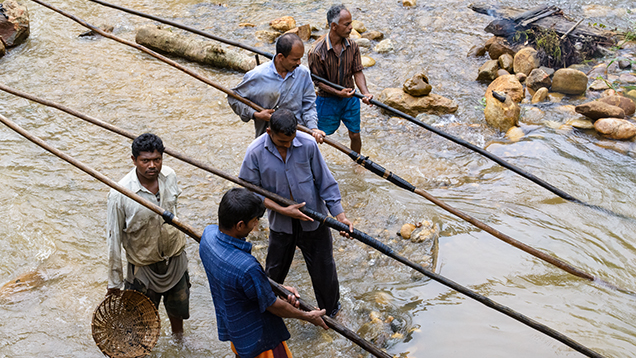Romancing the Source: Sri Lanka
June 15, 2015
Sri Lanka
Join us in a gemstone treasure hunt by viewing this video. In true ‘Reality TV,” you will witness the perils and effort involved in mining colored gemstones and bringing them to the market.
This series of articles and videos follows a team of GIA Field Gemologists on their travels from the mountains of Afghanistan to the jungles of Sri Lanka in search of the sources of colored gemstones and the people who pursue them. This thrilling journey will take you to remote gemstone-mining areas, where you’ll witness the extreme effort required to wrestle nature’s treasures from the earth.The romance of a colored gemstone arises from its beauty, the exotic qualities of its source’s location, the adventure leading to its discovery, and the stories of the people who seek it. These factors have united to create the allure of gemstones through the ages, and continue to do so even in modern times.
Sri Lanka is one of history’s most famous gem sources, providing gemstone lovers with numerous varieties for centuries. Sri Lanka is famous for sapphires of all colors, and large, fine examples grace the exhibits of museums and royal jewelry collections. Traders—from the ancient Romans, Arabian sailors, European colonial powers, to the new rising wealthy class in China—have always coveted gems from Sri Lanka.
Mining practices in use today have centuries of tradition behind them. Thousands of pits measuring 2x2 or 2x4 meters and between 5 and 25 meters deep are found in the common mining areas of Ratnapura (which literally means city of gems), Elahera, and Balangoda. The miners dig down until they reach the gem-bearing gravels, which they haul up for washing in hopes of finding gemstone treasure.

Sri Lanka’s gemstone and jewelry industry blends traditional practices and experience with the needs of the modern global market. Photo by Andrew Lucas/GIA.
These traditional mining methods have maintained gemstone supplies for centuries and provided opportunity for large numbers of miners. Methods are also environmentally sound, as Sri Lanka requires that the pits and environment be restored after mining. This philosophy allows mining and agriculture to coexist, with miners sometimes working in rice paddies.Experienced Sri Lankan traders also travel the world in search of sapphire and other gems, stopping in places like Madagascar, Tanzania, and Mozambique. They return with gemstones to be cut and processed in their own country and sold to the world markets. The Sri Lankans are also masters at heat-treating sapphire to improve color and transparency.
The new generation of Sri Lanka gem traders comes from a long tradition, building upon the wealth of experience inherited from their fathers and grandfathers and adding new practices for the modern global market.
About the Authors
Andrew Lucas is Manager of Field Gemology at GIA in Carlsbad, California; Tao Hsu is Technical Editor of Gems & Gemology.
Acknowledgements
National Gem and Jewelry Authority of Sri Lanka, the entire gem and jewelry industry of Sri Lanka, and the people of Sri Lanka.



